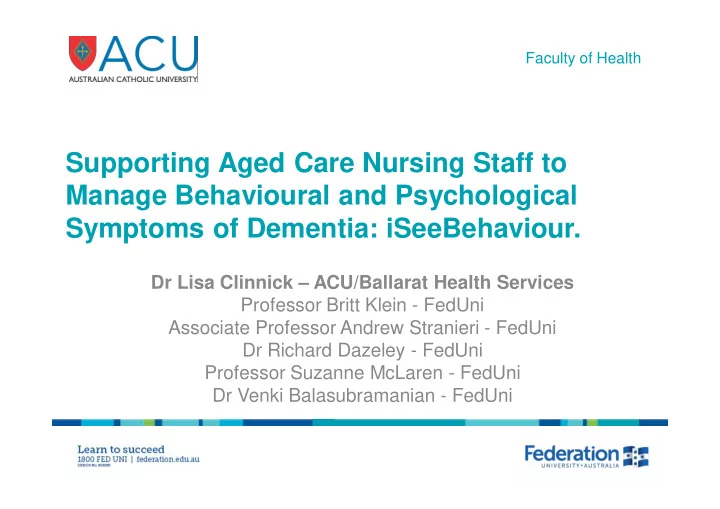

Faculty of Health Supporting Aged Care Nursing Staff to Manage Behavioural and Psychological Symptoms of Dementia: iSeeBehaviour. Dr Lisa Clinnick – ACU/Ballarat Health Services Professor Britt Klein - FedUni Associate Professor Andrew Stranieri - FedUni Dr Richard Dazeley - FedUni Professor Suzanne McLaren - FedUni Dr Venki Balasubramanian - FedUni
25%-50% Faculty of Health 47.7% Rate of NH rate of Sydney NH residents on residents receiving psychotropic psychotropic medication medication (2006) (1988) 2003 Helsinki 60% study UK 2009 of residents receive one 79.9% of residents Dementia Framework psychotropic medication prescribed submission – 37% psychotropic receive two medications “estimated that we are 11% treating 180,000 people with receive three or more. dementia with antipsychotic (1988) medication across the 20% country per year. Of these, up The number of residents to 36,000 will derive some receiving psychotropic benefit from the treatment” medications who did not have a diagnosis (1994)
Background Faculty of Health • Behavioural and psychological symptoms of dementia (BPSD), are common in aged care residential facilities. • Studies report that psychologically-based interventions can be used successfully to manage BPSD • identifying and knowing how to apply the most appropriate behavioural management strategy requires training or expertise.
Faculty of Health Psychotropic medications use • Side effects of all benzodiazepines include excessive sedation, • psychomotor slowing, • cognitive impairment, • morning “hang-over” effect, • ataxia and • falls • the overall side effect profile of both typical and atypical antipsychotics is vast..
Faculty of Health Project Aims: • to identify an appropriate approach toward the provision of tools that could be helpful to nurses when making assessments and choosing BPSD intervention strategies when attending to a resident in a short time frame. • be practically deployed • encourage a decision maker to exercise discretion • Developed NBA – Nurses Behavioural Assistant innovative and sophisticated psychologically-based mobile application and web-based system.
Faculty of Health Analytics Support Decisions • analytics keeps track of how often a specific intervention (for each individual BPSD type, per patient) is successful or not. • Nurses are shown these success scores when they opt to implement a behavioural intervention.
Faculty of Health Project Design- • program was implemented at an aged care facility located in regional Victoria, Australia • provided with an outline of the research at two staff training days. • brainstorming session • DKAT completed
Faculty of Health Initial Feedback • Size • Common BPSD identified • common interventions identified • Time
Resident Assessments Faculty of Health • Selection • Assessments – • Saint Louis University Mental Status Examination (SLUMS). • Hospital Anxiety and Depression Scale (HADS).
Trial Results Faculty of Health • Staff feedback • It was easy to use. • It was hard to classify resident by room number vs name. • No inclusion of staff member directed behaviours, this doesn’t fit into a category. • Possibility of using the app at home to log incidents after work using a pass code. • Also, the possibility of including a timeline of incidents per residents.
Findings Faculty of Health • behaviours have not coincided with what has been placed into the resident logs. • Residents are being provided with medication as the first response in a number of incidents. • Nursing staff may not have classified these as problem behaviours.
Limitations Faculty of Health • Nursing staff were enthusiastic about the system concept, however as they have extensive training already they did no use it. • Small facility was used in this trial • Small sample of residents for a limited time period. • A whole facility approach would have overcome some of the limitations
Faculty of Health Phase 2 - iSeeBehaviour • Further development using grant funds. • Enhanced graphics and analytical power. • Easier use for staff. • Simpler and more engaging platform. • Supported with evidence based best practice strategies. • Nurse Self Care Mindfulness, meditation and stress management strategies for staff to use on themselves.
Faculty of Health
Faculty of Health
Faculty of Health
Faculty of Health
Faculty of Health
Faculty of Health
Future Faculty of Health • Conducting RCT of updated iSeeBehaviour platform. • Enormous support and enthusiasm from Melbourne based health services and national aged care providers. • Expect interest to grow further once evaluation has been conducted.
Recommend
More recommend